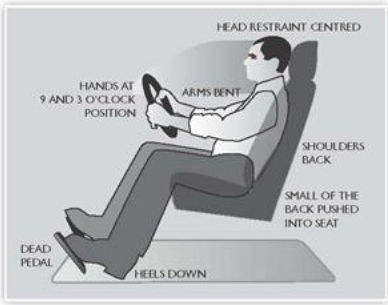Your Posture Does Matters While Driving

Most drivers pay little attention to their posture while behind the wheel.
Like brushing your teeth or riding a bike, the act of driving becomes so automatic that we push technique and posture into a mental blind spot. Seriously, when last did you think about the use of your neck or hands while cruising down the highway?
Well, it’s a good idea to start rethinking your posture again. The way you steer, sit and shift in your seat can affect the way you drive, the way you feel while driving and the way you feel about driving.
Perhaps, you learned what the best driving position looks like in driving school years ago, but you may have suffered a memory dump over the years. Or maybe you were never taught. Whatever the case, we’ve got notes for you to take.
Is there a Best Driving Position?
So what does the best driving position look like? Is it a specific pose such as what you’d see in a painting at a museum? Is there even such thing as a proper driving position?
The answer is yes and no.
It sure is a contradictory answer, but the “best driving position” is context-specific. In other words, there is a standard way to carry yourself behind the wheel, but you might have to make subtle adjustments based on a few factors.
What Determines Your Posture While Driving
- Height
- Body type/weight
- Physical/health conditions (more on this to come)
- Road conditions (bad weather or road obstacles may require more attentive posture)
- Focus (driving for performance requires tweaked posture from what’s used in regular driving, which we’ll soon discuss)
Any one of these factors or a combination of them could trigger a change in your posture (which often happens subconsciously). With that said, the deviation from the standard posture needs to not be too drastic.
Sitting Pretty for Safety
Your top priority when sitting behind the wheel is not getting from point A to B, but rather, to drive responsibly. No other consideration in driving rivals the importance of safety.
When discussing driving safety habits, posture is everything. Good driving posture can mean the difference between reaching your intended destination, or spending time in the ER.
Of course, obeying road rules and showing empathy to others are key ingredients for road safety. But it is good positioning that keeps your mind alert, your senses sharp and your limbs responsive as road conditions change.
With that said, here’s what the ideal “safety” position looks like.
Ideal driving posture for overall safety.
Best driving position for overall safety
- Center your skull on the head restraint without leaning too far back (to prevent sleepiness and allow for wider head motion to check blind spots and mirrors)
- Keep your shoulders back and hold your torso up without straining or forcing
- Push the small arc of your back into your seat (this helps maintain the natural arc in your back)
- Keep your arms slightly bent so that it’s neither perfectly straight or touching your legs (for greater steering control)
- Fix your hand at the 9 and 3 o’clock position (this allows for smoother control of the wheel, especially for cases where you have to make sharp turns)
- Extend your legs enough so that you can easily reach the pedal, but bend your knees slightly
- Keep your heels down and rest the ball of your feet on the pedal lightly (this helps you control your acceleration and braking)
This posture in many ways serves double duty for you as a driver.
Seated in this position, your hand-eye coordination will function better, giving you more control over your vehicle to steer away from potential road dangers.
It also supports the natural curvature of your spine and body alignment, so that you avoid excess strain which tends to aggravate existing pains. That brings us to our next point.
Healing in Motion
Not everyone is playing (or in this case, driving) with the same deck of cards when it comes to well-being and comfort. In other words, a number of you carry the burden of chronic illness, injuries and other physical states. And they can make driving a real pain (excuse the pun).
Driving while sore
Driving tends to aggravate body aches, especially those of the lower back. Long road trips, for example, put pressure on the spinal joints, and the spine itself has to withstand much vibration.
To make things worse, modern cars tend to have low seats that are tipped back (to accommodate low roof lines), which strains the hamstrings and pelvis. For this reason, individuals with back troubles often ditch cars for SUVs and trucks.
The way you sit while driving can worsen or lessen the discomfort you feel, so it’s worth learning the best driving position for your unique physical needs. This is where slight postural shifts and seat adjustments may vary slightly from person to person.
With that said, you shouldn’t completely disregard the ideal safety posture mentioned in the previous section.
Best driving position for aches and pains

Ideal posture for back pain.
- Raise your seat or yourself by sitting on a cushion or pillow (reduces strain on your spine and hips)
- Move the seat forward so that the gas, brake and clutch pedals are easy to reach
- Adjust the angle of your seat to keep your knees lower than your hips (prevents pelvis from rolling forward which can cause pain)
- Remove your wallet from your back pocket as this leads to asymmetry of the hips (and aggravates pain or scoliosis)
- Adjust your mirrors to cover your field of vision, so that you’re not twisting and turning to see around you (these repetitive motions can trigger muscle aches and spasms)
- Don’t sit too close or too far from the wheel (nor should your seat recline too far forward or backward)
- Tilt your steering wheel down towards you to reduce the strain on your neck and back
Driving with a baby bump
For all of you ladies out there about to have a baby, we feel for you. Carrying a miniature “you” for nine months isn’t always comfy, and driving while pregnant isn’t any more pleasant. And it also brings a degree of risk.
In fact, pregnant women have a slightly elevated chance of getting into an accident. The Canadian Medical Association Journal published a study in 2014, revealing a 42% increase of car crashes among women in the middle of three months of their pregnancy.
On average, there are 4.3 visits per year per 1,000 women to the ER due to traffic accidents. However, that number increased to 7.7 when women reached their second trimester.
No one knows for sure why this is the case. However, Dr. Rallie McAllister, an MD, MPH, family physician and coauthor of “The Mommy Guide to Pregnancy and Birth”, said “it could be related to fatigue, mental distraction, or the physiological changes related to pregnancy.”
Of particular concern to pregnant women are the vulnerabilities of their unborn baby, and the well-being of a soon-to-be mother while on the road. Fortunately, there are some practical tips on posture and positioning that can help pregnant women stay cozy and protect their child.
Best driving position for pregnancy

Ideal posture for pregnancy.
- Keep the seat belt under your abdomen and the shoulder belt between your breasts
- Avoid tucking the shoulder strap under your arm
- Move your seat back so that your abdomen is at least 10 inches from the steering wheel
- Tilt the steering wheel away from the abdomen towards the chest
- Keep your shoulders back and avoid leaning too close to the wheel
- Extend your legs but keep a slight bend at the knees to reach the pedals more comfortably
- Travel with another licensed driver and sit in the passenger seat if you’re nearing your due date
Unlike wine and hot tubs, driving is not off limits for pregnancy. But it calls for added care. The best driving position for pregnant women, described above, can help shield your unborn bundle of joy from injury if an accident occurs. Additionally, these minor adjustments can bring an added degree of comfort for longer trips.
A “Win-Win” Position
What separates great drivers from the average ones? Is it gender? Genetics? Perhaps. But like many activities, it boils down to technique, and great drivers know how to use their bodies to gain more control of their vehicles. They recognize that there is a best position for performance driving.
Now driving with a focus on performance doesn’t have to mean hitting Fast & Furious speeds on residential streets. It can also refer to making the most of your car, and the experience of driving it with as little effort as possible.
Along the spectrum, there are various skills to master, such as steering, braking and even your eye placement for better focus. Of course, you need to get a grip on sitting and seating posture since they affect the ease at which you execute these driving skills.
Now as a word of caution, we recommend that only strong drivers focus on this type of posture. Performance driving isn’t the same as regular driving (hence why we have racing schools), so this style is for those who can handle their rides and themselves.
You know who you are.
Best driving position for performance driving
- Start off with your hands at the 9 O’clock and 3 O’clock position or 8 O’clock and 4 O’clock position (neutral positions which are best for steering)
- Avoid hooking (holding the wheel with your palm and forearms facing up), palming, 12 and stick, and 10 and 2 positions (they reduce steering mobility)
- Keep your arms extended with a slight bend at the elbows
- Keep a bend at the knees (the steering wheel shouldn’t be able to touch your knees)
- Sit upright (as opposed to relaxed), neither too far or too close from the steering wheel
- Adjust the height of your seat so that you’re not too high (so that you don’t hit your head) or too low (so that you can’t see well above the dashboard)
- Relax your grip, don’t “choke” the wheel





